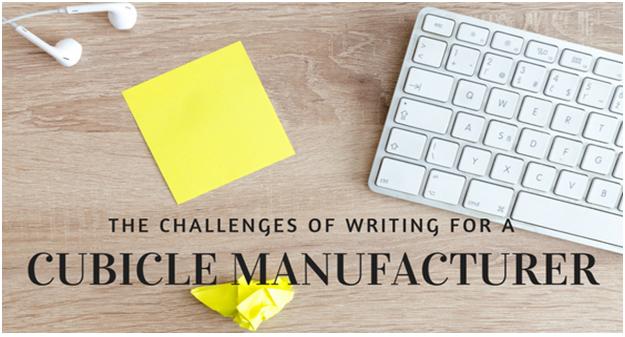As a content marketing specialist, it’s my job to create interesting, engaging, creative, and informational content that can be marketed and in turn, drive traffic to our website. Doesn’t seem too complicated, right? But, did I mention that I’m writing for a cubicle manufacturer? Suddenly that simple task got slightly more challenging. How am I supposed to write an average of three posts a week about office cubicles and actually make people want to read it? It seems impossible. However, after a couple weeks of training, reading numerous articles about related topics, and writing a few pretty bad pieces, I think I finally got the hang of it. After overcoming a few of these challenges (which I face with each new blog post) I’ve managed to generate some useful content which has really seemed to increase the traffic to the company’s blog and website.
So, how do I do it? I’ll explain each of the daily challenges that I face and how I overcome them and hopefully this will help you when writing content for your boring niche. After all, it doesn’t have to be as dull and boring as you might think.
- Developing an Engaging Topic
This is probably the most difficult part; coming up with a topic related to your industry, using your relevant keywords, that your audience wants to read about. I start by doing a general search for other relevant articles in my industry, such as “office cubicle blog,” “office design blog,” and “office furniture blogs,” to see what my competitors or other related blog sites are writing about and which topics are most popular. It may seem like your options are limited, but even with an industry as niche as “office cubicles,” there are hundreds upon hundreds of topics to write about.

I try to come up with something that I might want to read if I came across that title in a Google search. Or at least something that would be worthwhile for me to read. The topic should at least be either engaging or informative if not both. An example of an engaging topic that I’ve written is, “The Benefits of a Dog-Friendly Office.” An informative topic example would be, “The History of the Cubicle.” It’s not as exciting as reading about dogs, but it’s informational and you’ll learn something from the post. A couple examples of posts that are both engaging and informative are “25 Office Cubicle Organization Ideas,” and “15 Ways to Make Your Cubicle Less Boring.” Not only will you learn useful information and tips, but the topic is interesting and captures your attention. It makes you want to read more.
- Becoming Knowledgeable About the Topic

After I choose a topic, I spend some time researching my chosen topic. I want to be an expert on whatever I’m writing about. As a 22-year-old recent college graduate, my knowledge about office cubicles and offices in general is minimal, yet I’m calling myself the “cubicle specialist.” In order to live up to my name, I want to have a complete understand of the topic that I’m writing about. This is true for any topic written by any author. Know your topic. You’re teaching your readers; therefore, you should understand what you’re teaching. Don’t simply just make up facts. That doesn’t make you a very reliable or trusted source.
- Creating Content that Readers Can Relate to and Want to Read About
Unfortunately, it’s not enough to only have an engaging topic, now you need to create engaging content. Hopefully, if you’ve chosen a good topic, the content shouldn’t be too difficult. Tell stories and share your personal opinion and feelings to make your writing more relatable. Every writer has their own tone; don’t be afraid to write in yours. Write like you’re talking to someone. If your writing gets to formal, it can sound dull and uninteresting. The content should be real and relatable. Add humor and truth to your piece.

I try to use my own experience in my writing. From what little experience I have. I’ve only worked in an office setting for a little while, but you can learn a lot in 40 hours a week. And I definitely have my own unique tone. I always write in a variation of that. Sometimes slightly more formal, depending on the topic, but still in my own voice. This alone can make your writing more interesting to read and more relatable.
Make use of your main keywords throughout your piece. But, be careful not to go overboard. An average rule to go by is to use your keyword in your article about three times every 800 words. This should come naturally if your topic is relevant to your industry (which it should be). Try to put the keyword in the title as well.
Once your piece is written and edited, it’s time to publish and market it. Get your content seen. What’s the point in putting that much time and effort into a great blog post if no one sees it? Use various social media platforms to distribute your piece. Distribute your content through emails to other relevant bloggers and websites. Generating backlinks is one of the single most important pieces of effective content marketing. If you’re content is creative, engaging, and informational, you should have no problem getting it picked up by a few sites. This process can be tedious, but the results are 100% worth it. And now you have the skills and tips to create amazing content every time. Even if your industry is a little boring.





